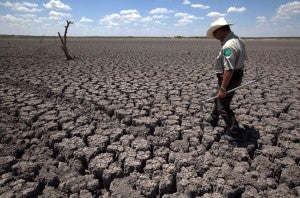It’s Time Our Policies Reflect The Fact That Energy And Water Are Fundamentally Intertwined
 When I tell people that the best way to conserve energy is to conserve water, I am often faced with a confused response. I’m not surprised really. Energy and water policies are rarely discussed in the same forum. For a long time, we’ve overlooked the inextricable relationship between water and energy use. Coal, nuclear and natural gas plants use enormous amounts of water for cooling purposes. In 2005, 41% of all freshwater withdrawals in the nation was used in the thermoelectric power industry for cooling.
When I tell people that the best way to conserve energy is to conserve water, I am often faced with a confused response. I’m not surprised really. Energy and water policies are rarely discussed in the same forum. For a long time, we’ve overlooked the inextricable relationship between water and energy use. Coal, nuclear and natural gas plants use enormous amounts of water for cooling purposes. In 2005, 41% of all freshwater withdrawals in the nation was used in the thermoelectric power industry for cooling.
Connection between energy and water
The longstanding division between energy and water considerations is particularly evident in the case of energy and water management. These resources are fundamentally intertwined: Energy is used to secure, deliver, treat and distribute water, while water is used (and often degraded) to develop, process and deliver energy. Despite the inherent connection between the two sectors, energy and water planners routinely make decisions that impact one another without adequately understanding the scientific or policy complexities of the other sector. This miscommunication often hides joint opportunities for conservation to the detriment of budgets, efficiency, the environment and public health, and inhibits both sectors from fully accounting for the financial, environmental or social effects they have on each other.
This lack of collaboration between energy and water planners is especially dire considering Texas is in midst of an energy shortage that is exacerbated by the multi-year drought. Without adequate planning, we could someday have to choose between keeping our lights on and turning on the faucet.
Need for efficiency

Energy and water infrastructure upgrades are expensive, and this reality continues to stifle the transition to a more water and energy efficient system. Energy and water policies at both the federal and state levels were developed to support existing electricity generation and water technology, but conditions have changed dramatically and the policies haven’t kept up.
Competitive markets, new technologies, resource constraints and increasing greenhouse gas emissions are all part of the new planning reality, but are not adequately addressed when energy and water planning are carried out in siloes. At the most basic level, even the language between the two sectors does not match up, making it difficult for energy and water planners to speak to each other effectively. But don’t think this lets regulators and policymakers off the hook.
Policy
There have been calls for joint water and energy resource management. In 2011, the U.S. Energy and Water Research Integration Act was formulated “to ensure consideration of water intensity in the Department of Energy’s energy research, development, and demonstration programs to help guarantee efficient, reliable, and sustainable delivery of energy and water resources.” Although it was not enacted into law, this bill put the energy-water nexus on the national stage. Later, in the 2013 Texas legislative session, Senator Kirk Watson nearly passed a bill (Senate Bill 199) that would have required electricity generators to report their water use and needs annually. While some lawmakers have a clear vision to address energy and water needs together, we lack a consensus and broad understanding among stakeholders to make that vision a reality.
To compound the problem, energy and water resources are managed at multiple levels—local, regional, statewide and national. Having these different planning and regulatory levels means more opportunities for miscommunication or misalignment of policy goals from each sector. Addressing energy and water on a more coordinated basis could help overcome language barriers between the two and ensure that each resource is more adequately protected.
Energy and water management is too crucial to be upheld by disjointed decision making that doesn’t look at the whole picture. While it may be difficult to breakdown the longstanding separation between energy and water management, doing so will reveal novel conservation strategies to ensure Texans – or anyone else for that matter – never have to choose between keeping our lights on or running water to meet our daily needs.
This is one of a group of posts that examines the energy-water nexus, Texas’ current approach to energy and water policy and what Texans can learn from other places to better manage its vital resources.











One Comment
The blog title speaks for itself. Environmental policies should now be strengthened and enforced to its fullest extent nowadays. Transparency in the corporation’s reports should be strongly adhered to most especially when it comes to water usage. A single car requires 39K+ gallons of water in order for it to be produced and we can just imagine how much gallons of water are used for other vehicles. Water is very essential to life and a lot of countries nowadays are on their waterpeak. In order to prevent this thing to happen, our lawmakers should be vigilant in pushing the necessary bills/laws that would be sensitive to our environment and to all of us as a whole. People should also start doing simple energy and water savings at home or even in office. A lot of companies right now are pushing for paperless transaction or any other initiative that would lessen paper usage such as Microfilm Conversion among others. Let us all go green and help one another in order for the future generation not to suffer from our selfishness and lack of action. Imagine our youngsters asking us, “What have you done?” or “Why didn’t you do it when you had the time?”.